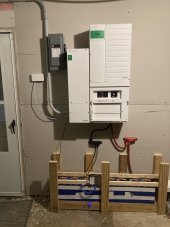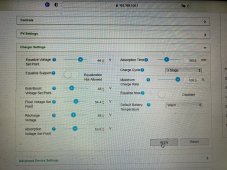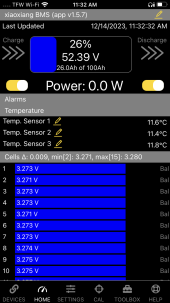If I'm understanding my installation/owner guide, the parameter is the voltage at which the mppt initiates that charge state. so absorption kicks in at 53.6 and float kicks in at 54.4. Correct me if I'm wrong, I'm a little confused about some of this.
Appears your setup is off grid. With the fortress battery pack I have, if I used a Schneider Inverter om off grid,
these would be the MPPT settings:
 This Chart applies to the fortress batteries, but may not apply to your EVE 280 AH.
This Chart applies to the fortress batteries, but may not apply to your EVE 280 AH.
To me the 54.4 Absorption/ Boost Float makes a lot of sense.
When a battery charges the Absorbtion/Bulk is trying to put 54.4 volts in, but because the battery is drained from a night's use, the it can't push that much voltage in so it sends as much amps into the battery as it can, or to the max amp limit you set on the MPPT/Charger. If this is 30 amps, you'll see the voltage slowly climb while it takes 30 amps until it hits 54.4. Up to now is the constant current. Once this 54.4 volts is hit,the voltage will stay at 54.4 but the amperage will taper down. Once it gets full and can't take any more amperage, the voltage floats.
Normally the float voltage is lower than the absorption voltage.
Some references even do not recommend a floating. Perhaps a lithium battery will last longer with no float stage.
With no float, the battery will not start charging again until it gets down to the recharge voltage. Unfortunately for the off gridder,
you find yourself in a situation where it may be at 53.1 volts getting near sunset and that leaves you in a state where you go
start a night with a lower battery.
The float voltage keeps this towards 100%. IME,
if float is set too low, the battery
does charge, but it the panels may be able to pull 100 amps from the sun, the load may be 80 amps, but because the float is too low, the MPPT only delivers 30 amps,
leaving the 50
amps to come from the battery. So, again a situation where the batteries are draining themselves to a lower state for when the sun goes down, you don't start with a full pack. This probably gives you marginally less total cycles than not floating.
IME,
Keeping float at bulk voltage allows the MPPT to pull as much power as possible from the MPPT and panels. On a piece of paper and a chart, there may be less charging cycles than the other two options, but
when the sun sets, your batteries will be at their max charge state.
Also IME, not included in the life cycle of a battery chart is when because float was set to off or set too low, the battery went into the night at 50% SOC, and the inverter drained it overnight to the point the BMS tripped, draining the battery to nothing also shortens the life cycle, so IMO, the risk is worth a higher float.
=================
A couple other things.
First with these Eve 280 cells there is not that much data published as in tech specs. That leaves you having to guess with what you can find and internet searches.
Second, you have a Tier 1 Inverter with the Schneider, and this Tier 1 inverter is paired with Eve 280 Ah. Not many people will have that combination, so it will feel like you're blazing new trails. There's a lot of cheaper inverters out there paired with Eve 280s, but not a lot of Tier 1 inverters paired with Eve 280s.
=================
The stuff I mentioned above is from my experience with a smaller solar generator and 25 ah TopBrand cells I assembled into a battery with a generic BMS, that helped me install 2 X 8S EVE 280 AH Cells into 2 batteries each with a Overkill BMS for my RV.
Last week, the installers finished setting up my Outback that is paired with the FOrtress batteries I linked above, and I'm using that to tweak their settings. I found the installer had set a "off grid" time for me that was way too long and got my battery pack way too low, and I shortened that from 10 hours to 1 hour, and also a second setting which they had set a wake amperage for one of my MPPTs way too high, which cost me a few kWh producrion on a cloudy day.
So I'm pretty new to the Tier 1 inverters also.






